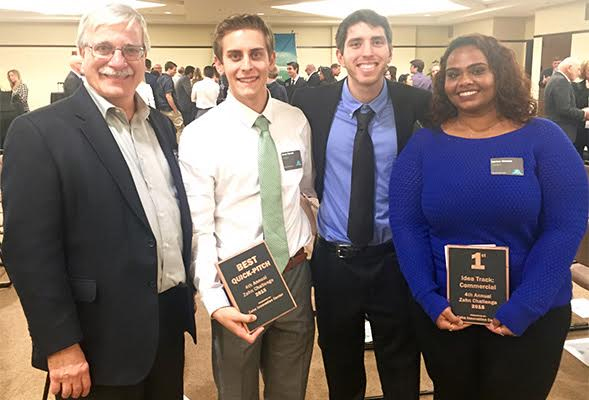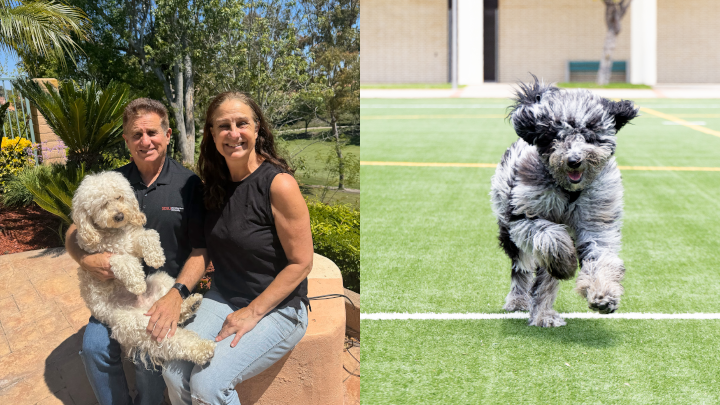Helping Those with MS
This year's Zahn Challenge winners are working toward a system that detects Multiple Sclerosis.

“We want to help improve the quality of life for people with Multiple Sclerosis.”
Jason Peretz, a senior business major, is the co-founder of LaserClean, a technology system used to detect Multiple Sclerosis biomarkers in blood samples.
The team recently took first place in the annual Zahn Challenge. They recently received funding from the prestigious National Science Foundation.
1) How did you get this idea/ Where did the inspiration come from?
We interviewed a man named Jim Jackson who is my partner's uncle. He was an orthopedic surgeon who operated on famous football players. He started showing symptoms of a spinal problem and received two surgeries. After the surgeries, his symptoms came back and they found that he had been misdiagnosed.
He received a spinal tap which was one of the worst experiences of his life. Then, he was misdiagnosed with another disease and doctors prescribed steroids. Three years and hundreds of thousands of dollars later, he was finally diagnosed with MS.
During the three years he was not diagnosed with the disease, it was not treated and created permanent lesions on his brain. He now has life-long disabilities because of the slow the diagnosis process. He will never be able to perform surgery again.
Zarina Munshi, Alexander Jackson and I came together and interviewed several other people with MS and realized they told similar stories. We realized there are serious problems with the diagnosis process.
On average, it takes several years for a patient to be diagnosed with the disease, from the time they first start showing symptoms. We are developing a method to aid in the detection of MS. With our patented technology, we are working on detecting MS biomarkers in blood samples.
Our end goal is to be able to detect the disease with a simple blood test, but for now we are looking to replace the spinal tap procedure. Ultimately, we chose to work on detecting Multiple Sclerosis in blood because we were inspired by Jim Jackson as well as every other patient, doctor, biotech corporation and foundation we have spoken too.
2) What does your company do?
Our company is going to help aid the detection process of MS. Our ultra-sensitive technology will significantly decrease the amount of time it takes for a patient showing symptoms of MS to be diagnosed.
We are creating a blood test that will hopefully replace spinal taps and show more positive results that a patient has the disease. By shortening the diagnosis process, we can help patients get treatment before the disease creates permanent holes in their brain. We want to help improve the quality of life for people with MS.
3) How has SDSU helped you be successful?
SDSU has been the best support system for us. We were able to to patent our technology through the university. Tommy Martindale in the Tech Transfer Office has been working with us on all the legal aspects of utilizing the technology. We receive weekly advice from William Tong who is the chemistry department chair, as well as a distinguished professor in chemistry and biochemistry, analytical and physical sciences. Most importantly, he is the inventor of the original technology.
4) What has your biggest challenge been and how have you overcome it?
Currently, our biggest challenge is balancing school and research. After I graduate in May, I plan on working full time to commercialize LaserClean.
5) What are the next steps and/or future goals?
Our most recent milestone was winning the Zahn Challenge. We are currently in the proof of concept stage, and once we are done, we will move to clinical trials. Munshi and Jackson have been working extremely hard in the lab and making great progress.
With the small grant we received from the National Science Foundation, we have been getting our feet wet in the industry to determine our business aspects of commercialization. We will have a presentation of our technology in the beginning of January for the California State University Innovation Corps program.
6) Are you involved with anything else at SDSU?
I used to be involved with many organizations at SDSU, which consumed all of my time outside of studying. Last semester, I ran for vice president of financial affairs. Although I did not win, it was a great experience which helped me polish my public speaking skills.
7) How has your involvement with the Zahn or Lavin Center helped prepare you for this/helped your business grow?
I am in the Lavin 2014-16 cohort, which is a program that hand selects about 20 students every year for their 2-year program. The program is designed to provide students with resources to start their own company. Bernard Schroeder and Alex DeNoble are coordinators and instructors of the program and have provided me with tons of mentorship. LaserClean is now in the Zahn Center, where Cathy Pucher has helped steer our team in the right direction.



